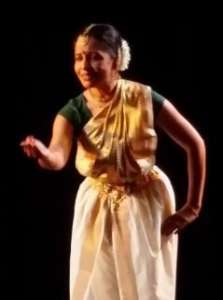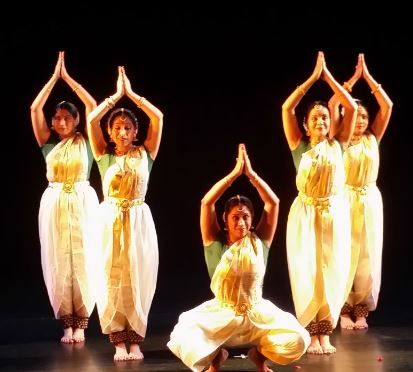 GEETHA PATIL
GEETHA PATIL
CAMBRIDGE, Massachusetts: Natya Dance Collective presented a Bharatanatyam dance performance on the theme, “Samsara: Dancing the Everyday” at the Dance Complex, Cambridge, Massachusetts, May, and another one June 1 in the presence of a large number of dance lovers from different locations of Massachusetts.
The performance of Bharatanatyam by the dance company reflected upon the significance of everyday experiences such as love and loss, searching without end, and the complexities of human relationships with the rhythms of the drum and new music by Carnatic saxophonist and composer Prasant Radhakrishnan. The Samsara dance group comprised young, energetic and beautiful dancers, namely Smitha Radhakrishnan, Aditi Subramaniam, Usha Narayana, Divya Satishchandra, Gowri Vijayakumar, and Kavya Prasad. They presented both classical and contemporary pieces choreographed by Natya dancers from around the Boston area
In Natya Dance Collective, the professionally trained Bharatanatyam artists work together and bring out both traditional and contemporary choreographies by integrating Bharatanatyam movement vocabularies with eclectic musical scores, English narrative, and cross-cultural conceptual frameworks to reach a culturally diverse audience.
Smitha Radhakrishnan, the artistic director founded Natya Dance Company with Vallari Shah in Oakland, California. In 2008, Radhakrishnan moved to the Boston area and continued studying Bharatanatyam. She started her own Natya Dance Studio in Natick in 2015, which is now offering classes for children and adults, as well as open studio sessions for advanced dancers. In her professional life, Radhakrishnan is Associate Professor of Sociology at Wellesley College.
The Samsara team presented six dance performances: “Daughter of the Earth” (Pushpanjali) to invoke the blessings of Ma Sita,; “The Bloom Opens” (Talamalika Alarippu) that depicted the process of an opening flower, requiring control of fingertip, neck, and shoulders; Sambandha that presented human relationships with emotions like pain and joy, togetherness and alienation in four stories; “Thirsty Fish” (Bhajan: Paani Mein Meen Pyasi) that described how a fish was feeling thirsty even though surrounded by water; “O Friend, What Can I Do?” (Padam: Bhamaro Napaai) that illustrated the longing feeling of a lady for her lover; and “A Jewel to Recognize Me” (Thillana) that narrated the miracle that allowed Hanuman to bring Rama’s jewel to Sita across the treacherous sea.
The narrative given in between the dances was very helpful to the audiences to understand the story of the dance. Radhakrishnan thanked the audiences for coming and enjoying the dance performance. She thanked the Dance Complex’s board of directors and the staff for providing the venue and appreciated their help with light and sound as well. All the dancers spent time with the spectators and answered their questions.







